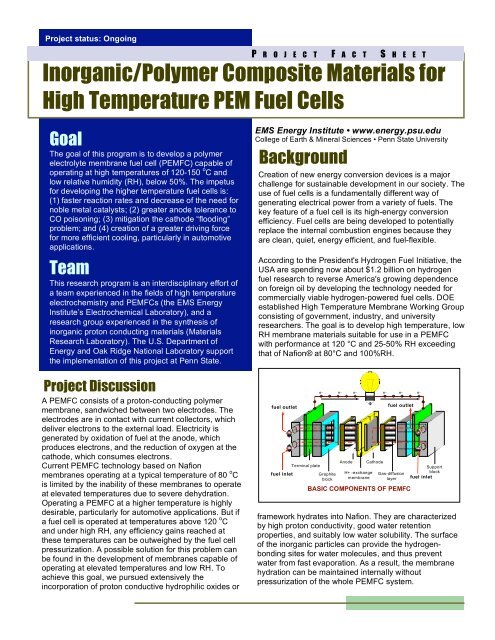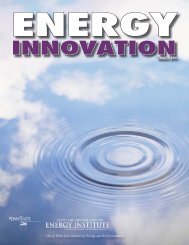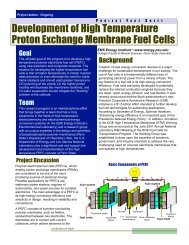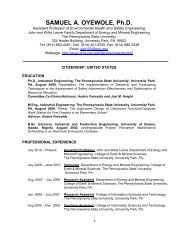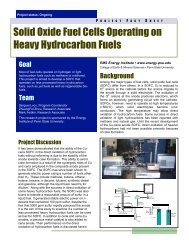Inorganic/Polymer Composite Materials for High Temperature PEM ...
Inorganic/Polymer Composite Materials for High Temperature PEM ...
Inorganic/Polymer Composite Materials for High Temperature PEM ...
Create successful ePaper yourself
Turn your PDF publications into a flip-book with our unique Google optimized e-Paper software.
Project status: Ongoing<br />
P R O J E C T F A C T S H E E T<br />
<strong>Inorganic</strong>/<strong>Polymer</strong> <strong>Composite</strong> <strong>Materials</strong> <strong>for</strong><br />
<strong>High</strong> <strong>Temperature</strong> <strong>PEM</strong> Fuel Cells<br />
Goal<br />
The goal of this program is to develop a polymer<br />
electrolyte membrane fuel cell (<strong>PEM</strong>FC) capable of<br />
operating at high temperatures of 120-150 o C and<br />
low relative humidity (RH), below 50%. The impetus<br />
<strong>for</strong> developing the higher temperature fuel cells is:<br />
(1) faster reaction rates and decrease of the need <strong>for</strong><br />
noble metal catalysts; (2) greater anode tolerance to<br />
CO poisoning; (3) mitigation the cathode “flooding”<br />
problem; and (4) creation of a greater driving <strong>for</strong>ce<br />
<strong>for</strong> more efficient cooling, particularly in automotive<br />
applications.<br />
Team<br />
This research program is an interdisciplinary ef<strong>for</strong>t of<br />
a team experienced in the fields of high temperature<br />
electrochemistry and <strong>PEM</strong>FCs (the EMS Energy<br />
Institute’s Electrochemical Laboratory), and a<br />
research group experienced in the synthesis of<br />
inorganic proton conducting materials (<strong>Materials</strong><br />
Research Laboratory). The U.S. Department of<br />
Energy and Oak Ridge National Laboratory support<br />
the implementation of this project at Penn State.<br />
Goal<br />
Project Discussion<br />
This text should explain what the research goal is.<br />
A <strong>PEM</strong>FC consists of a proton-conducting polymer<br />
This text along with the ‘Team’ may not exceed this<br />
membrane, sandwiched between two electrodes. The<br />
blue column. (About 100 words <strong>for</strong> this section.) Font<br />
electrodes are in contact with current collectors, which<br />
should be Arial 10 point plain, in white.<br />
deliver electrons to the external load. Electricity is<br />
generated by oxidation of fuel at the anode, which<br />
This text should explain what the research goal is.<br />
produces electrons, and the reduction of oxygen at the<br />
This text along with the ‘Team’ may not exceed this<br />
cathode, which consumes electrons.<br />
blue column. (About 100 words <strong>for</strong> this section). Font<br />
Current <strong>PEM</strong>FC technology based on Nafion<br />
should be Arial 10 point plain, in white. This text<br />
membranes operating at a typical temperature of 80 o C<br />
should explain what the research goal is. This text<br />
is limited by the inability of these membranes to operate<br />
should explain what the research<br />
at elevated temperatures due to severe dehydration.<br />
Operating a <strong>PEM</strong>FC at a higher temperature is highly<br />
desirable, Team particularly <strong>for</strong> automotive applications. But if<br />
a fuel cell is operated at temperatures above 120 o C<br />
List team members. Font should be Arial 10 point<br />
and under high RH, any efficiency gains reached at<br />
plain, in white. (About 70 words <strong>for</strong> this section.)<br />
these temperatures can be outweighed by the fuel cell<br />
pressurization. List team members. A possible Font solution should <strong>for</strong> be this Arial problem 10 point can<br />
be plain, found in in white. the development List team members. of membranes Font should capable be of<br />
operating Arial 10 at point elevated plain, temperatures in white. List team and low members. RH. To<br />
achieve Font should this goal, be Arial we pursued 10 point extensively plain, in white. the<br />
incorporation of proton conductive hydrophilic oxides or<br />
List team members. Font should be Arial 10 point<br />
plain, in white.<br />
<strong>PEM</strong> Fuel EMS Cells Energy Institute • www.energy.psu.edu<br />
College of Earth & Mineral Sciences • Penn State University<br />
Background<br />
Creation of new energy conversion devices is a major<br />
challenge <strong>for</strong> sustainable development in our society. The<br />
use of fuel cells is a fundamentally different way of<br />
generating electrical power from a variety of fuels. The<br />
key feature of a fuel cell is its high-energy conversion<br />
efficiency. Fuel cells are being developed to potentially<br />
replace the internal combustion engines because they<br />
are clean, quiet, energy efficient, and fuel-flexible.<br />
According to the President's Hydrogen Fuel Initiative, the<br />
USA are spending now about $1.2 billion on hydrogen<br />
fuel research to reverse America's growing dependence<br />
on <strong>for</strong>eign oil by developing the technology needed <strong>for</strong><br />
commercially viable hydrogen-powered fuel cells. DOE<br />
established <strong>High</strong> <strong>Temperature</strong> Membrane Working Group<br />
consisting of government, industry, and university<br />
researchers. The goal is to develop high temperature, low<br />
RH membrane materials suitable <strong>for</strong> use in a <strong>PEM</strong>FC<br />
with per<strong>for</strong>mance at 120 °C and 25-50% RH exceeding<br />
that of Nafion® at 80°C and 100%RH.<br />
fuel outlet<br />
e- e- e- e- e- e-<br />
fuel outlet<br />
t can take up this column provided on the front, above the<br />
photo. (About 1000 characters with spaces total) It is to<br />
answer what the research is that you are writing about<br />
and why it is important. Font should be Arial 10 point<br />
plain, in black. This text can take up this column provided<br />
Anode Cathode<br />
on the front, Terminal above plate the photo. (About 1000 characters<br />
Support<br />
with fuel spaces inlet<br />
H+ -exchange<br />
total) It is to answer what Gas-diffusion<br />
block<br />
Graphite<br />
the research<br />
fuel inlet<br />
is that<br />
block membrane layer<br />
you are writing about and why it is important. Font should<br />
BASIC COMPONENTS OF <strong>PEM</strong>FC<br />
be Arial 10 point plain, in black.<br />
This text can take up this column provided on the front,<br />
framework above the photo. hydrates (About into Nafion. 1000 characters They are with characterized spaces<br />
by total). high It proton is answer conductivity, what the good research water is retention that you are<br />
properties, writing about and and suitably why it low is important. water solubility. Font should The surface be Arial<br />
of 10 the point inorganic plain, in particles black. This can text provide can take the hydrogenbonding<br />
sites <strong>for</strong> water molecules, and thus prevent<br />
up this column<br />
water from fast evaporation. As a result, the membrane<br />
hydration can be maintained internally without<br />
pressurization of the whole <strong>PEM</strong>FC system.<br />
.<br />
Font should be Arial 10 point plain, in black. This text can<br />
take up the 2 columns provided on the front, (About 1400<br />
characters with spaces total). Font should be Arial 10<br />
point plain, in black. This text can take up the 2 columns
Results<br />
Powders of inorganic additives were synthesized,<br />
cleaned, and characterized. A comprehensive<br />
experimental and theoretical study of solid<br />
nanomaterials <strong>for</strong> use in composite proton exchange<br />
membranes <strong>for</strong> high temperature <strong>PEM</strong>FC was<br />
conducted. A number of prospective hydrophilic<br />
inorganic compounds, including ZrO 2 , TiO 2 , Al 2 O 3 ,<br />
SiO 2, α-Zr(HPO 4 ) 2 , and H 3 OZr 2 (PO 4 ) 3 were analyzed<br />
with respect to their acid-base properties.<br />
Nafion/inorganic additive composite membranes were<br />
fabricated using different techniques and tested in a<br />
H 2 /O 2 <strong>PEM</strong> fuel cell over a range of RH from 13 to<br />
100% at temperatures of 80 and 120 o C. The<br />
incorporation of selected inorganic additives led to<br />
significant improvement of the membrane water<br />
retention properties and the <strong>PEM</strong>FC per<strong>for</strong>mance,<br />
especially, at low RH.<br />
Effects of TiO 2 content and TiO 2 surface properties<br />
such as specific surface area (SSA), morphology, and<br />
electrochemical properties on the per<strong>for</strong>mance of<br />
Nafion/TiO 2 composite membranes in <strong>PEM</strong>FCs were<br />
studied at RHs from 13 to 100% at temperatures of 80<br />
and 120 o C. The Nafion/TiO 2 composite membranes<br />
showed a marked improvement over unmodified Nafion<br />
membranes when operated at 120 °C and reduced RH.<br />
For instance, at 50% RH, the Nafion/20%-TiO 2<br />
membrane demonstrated per<strong>for</strong>mance comparable to<br />
that of bare Nafion at 80 o C.The composite membranes<br />
containing TiO 2 with SSA of 15.5 m 2 g -1 showed a<br />
significant advantage over the membranes containing<br />
TiO 2 with SSA of 2.9 m 2 g -1 . Thus, they provided much<br />
higher fuel cell per<strong>for</strong>mance at 120 °C and reduced RH<br />
presumably due to an increased number of hydrophilic<br />
sites inside the membrane. The higher zeta potential<br />
at TiO 2 /water interface is believed to be also an<br />
important characteristic responsible <strong>for</strong> the significant<br />
boost of the fuel cell.<br />
Nafion/zirconium phosphate (ZP) composite<br />
membranes with ZP of different structures were studied<br />
in an H 2 /O 2 <strong>PEM</strong>FC at the same conditions. The<br />
Cell Potential, V<br />
1<br />
0.8<br />
0.6<br />
0.4<br />
0.2<br />
0<br />
Al2O3<br />
alpha - Zr(HPO4)2<br />
TiO2-II<br />
Recast Nafion 26%RH<br />
0 0.2 0.4 0.6 0.8 1 1.2 1.4 1.6<br />
Current Density, A cm -2<br />
Per<strong>for</strong>mance of H 2/O 2 <strong>PEM</strong>FC based on Nafion composite membranes<br />
with different inorganic additives at 120 o C, 2 bar, and 13% RH.<br />
incorporation of all types of ZP into Nafion led to significant<br />
improvement of the <strong>PEM</strong>FC per<strong>for</strong>mance. The highest<br />
per<strong>for</strong>mance at 120 o C and reduced RH was demonstrated<br />
by Nafion/α-Zr(HPO 4 ) 2 with layered structure. Research on<br />
a new type of composite membranes (Nafion/Al 2 O 3<br />
membranes) is in progress. In an initial test, these<br />
membranes demonstrated per<strong>for</strong>mance even higher than<br />
that of Nafion/α-Zr(HPO 4 ) 2 membranes.<br />
The observed improvement in the per<strong>for</strong>mance of<br />
composite membranes is mainly attributed to two factors:<br />
(1) enhanced water retention of the new membranes due to<br />
hydrophilicity of inorganic particles, which in turn maintains<br />
high Nafion conductivity and (2) enhanced proton<br />
conductivity of the membranes due to the contribution of<br />
the highly protonated surface of inorganic additives.<br />
Key Contacts<br />
Serguei Lvov, lvov@psu.edu, (814) 863-8377<br />
Elena Chalkova, exc147@psu.edu, (814) 865-3280<br />
Mark Fedkin, mvf3@psu.edu, (814) 865-3280<br />
Key Publications<br />
Name, email address, (814) phone<br />
rs with spaces total). Font should be Arial 10 point plain, in<br />
E. Chalkova, M.V. Fedkin, D.J. Wesolowski, and S.N. Lvov, J. Electrochem. black. Name, email Soc. 2005, address, in press. (814) phone<br />
This text can take up the 2 columns provided on the back,<br />
E. Chalkova, M.B. Pague, M.V. Fedkin, D.J. Wesolowski, and S.N. Lvov, J. Electrochem. Soc. 152, 6, A1035, 2005.<br />
(About 2500 characters with spaces total). Font should be<br />
M.V. Fedkin, X.Y. Zhou, J.D. Kubicki, A.V. Bandura, S.N. Lvov, M.L. Arial Machesky 10 point D.J. plain, Wesolowski, in black. Langmuir This text 19, can 3797, take 2003. up the 2<br />
columns provided on the back, (About 2500 characters with<br />
M.V. Fedkin, <strong>High</strong> <strong>Temperature</strong> Microelectrophoresis Studies of the spaces Solid Oxide/Water total). Interface, PhD Thesis, The Pennsylvania<br />
State University, 2003.<br />
This text can take up the 2 columns provided on the back,<br />
E. Chalkova, X.Y Zhou, C.M Ambler, M.A Hofmann, J.A Weston, (About H.R Allcock., 2500 characters and S.N. Lvov, with Electrochem. spaces total and Font Solid should State be<br />
Letters, 5, 10, A 221, 2002.<br />
Arial 10 point plain, in black. This text can take up the 2<br />
columns provided on the back, (About 2500 characters with<br />
This publication is available in alternative media on request.<br />
Penn State is committed to affirmative action, equal spaces opportunity, total). and Font the diversity should of its be work<strong>for</strong>ce. Arial 10 (August point 2005) plain, U. Ed. in EMS black. 06-08<br />
This text can take up the 2 columns provided on the back,<br />
(About 2500 characters with spaces total). Font should be<br />
Arial 10 point plain, in black.


